How to Cite | Publication History | PlumX Article Matrix
Assessment of Occupational Health and Safety in Motor Vehicle Repair Workshops in Jeddah
Ijaz Ahmad1,2, Mohammad Rehan2, Mansour A. Balkhyour1 and Iqbal M. Ismail2
1Department of Environmental Science, Faculty of Meteorology, Environment and Arid Land Agriculture, King Abdulaziz University, P.O. Box 80208, Jeddah 21589, Saudi Arabia.
2Centre of Excellence in Environmental Studies (CEES), King Abdulaziz University, P.O. Box 80216, Jeddah 21589, Saudi Arabia.
Corresponding Author E-mail: mrehan@kau.edu.sa
DOI : http://dx.doi.org/10.13005/bbra/2524
ABSTRACT: This study aims to examine the occupational health and safety (OHS) status in motor vehicle repair workshops (MVRW) industry in the city of Jeddah, Kingdom of Saudi Arabia (KSA). An inspection tool composed of 10 OHS components and 69 items was employed through observations, interviews, walk through survey and focused group discussions. The data was collected from local workshops (LWs, N=62) and multinational companies’ workshops (CWs, N=11). The mean positive response for OHS components among surveyed LWs and CWs was as follow; personal protective equipment’s (PPEs) (28% and 61%), fire protection and emergency management (52% and 91%), provision of facilities (69% and 94%), electric safety (44% and 82%), general workshop safety (43% and 82%), housekeeping (18% and 84%), chemical exposure (16% and 69%), maintenance and services (54% and 86%), manual handling (84% and 100%) and tool safety (58% and 91%), respectively. The overall OHS mean positive response, complying best practices and regulations, of all OHS elements in LWs was 47% which was much lower than 84% positive response for CWs. The impact of OHS on workers’ health was also discussed together with recommendations given for further improvement.
KEYWORDS: Health Risk Assessment Motor Vehicle Repair Workshops; Occupational Health and Safety; Small Industry;
Download this article as:| Copy the following to cite this article: Ahmad I, Rehan M, Balkhyour M. A. Ismail I. M. Assessment of Occupational Health and Safety in Motor Vehicle Repair Workshops in Jeddah. Biosci Biotech Res Asia 2017;14(3). |
| Copy the following to cite this URL: Ahmad I, Rehan M, Balkhyour M. A. Ismail I. M. Assessment of Occupational Health and Safety in Motor Vehicle Repair Workshops in Jeddah. Biosci Biotech Res Asia 2017;14(3). Available from: https://www.biotech-asia.org/?p=27676 |
Introduction
The importance of occupational health and safety (OHS) in the small industry is gaining attention all around the globe. As safe and healthy workplaces promote physical, mental and social well-being along with enormous monetary benefits attributed to medical bills, insurance claims, and loss of work, experienced personal and corporate reputations and integrity of organization.1 A small industry has particular characteristics such as they are owned and controlled by independent owners who are the sole decision makers and predominantly contribute the operating capital in the business. 2 Owners and supervisors have little awareness of OHS legislation and associated regulation and give low priority towards it.3
Motor vehicle repair workshops (MVRW) are often small-scale enterprises. It is a labor-demanding sector and the workshop size, workers number and their job description differ significantly.3-5 Various studies showed that workers at small workshops face a range of workplace risks, hazards, and exposure. The use of cost-effective personal protection and other engineering controls have been well cited6. However, other aspects of workplace safety (fire, explosion, electric and machine-related hazards, chemical exposures) and programs needed to manage, control or minimize these issues are yet required to be explored further.3,6
The workers at MVRW face many physical, accidental, chemical, biological and ergonomic hazards along with toxic pollutant exposure from poly-aromatic hydrocarbons (PAHs), volatile organic compounds, heavy metals, particulate matter (PM), dust, exhaust, sulfur and nitrogen oxides. The commonly reported occupational health issues among mechanics are respiratory ailments, hearing loss, acute injuries, accidents, eyes injuries and musculoskeletal symptoms.3,5,6 Mechanics at MVRW may inhale fumes, vapors, and mist of used gasoline engine oil containing PAHs that carry the risk of cancer.7 Other reported health effects associated with long and short-term occupational exposure to crude or petroleum oil, dust, and other related pollutants are tumors, blood disorders, reproductive problems, reduction in growth, morphological problems and nephrotoxicity.7-9 Workers at MVRW work in unhygienic conditions, have little or no awareness of routine chemicals exposure and other hazards and do not regularly use personal protection equipments (PPEs) which can minimize the occupational health hazards.1,7
The assessment and regular monitoring of OHS standards at MVRW in Kingdom Saudi Arabia (KSA) is rarely published. This study aims to examine and compare the OSH practices, facilities, standards, workplace exposures, conditions and environment in the local workshops (LWs) and multinational companies’ workshops (CWs). An inspection tool, comprised of 10 OHS components and 59 items, was tailored and used by employing observations, walk-through surveys, focused group discussions and interviews. Field data was gathered from 62 recruited LWs and 11 multinational CWs. The OSH data from LWs and CWs was compared and recommendations were given for improvement in OSH.
Materials and Methods
Study Area
The study was conducted in urban areas of Jeddah, the second biggest developed and industrial city of KSA, having a population of around 4.03 million.3 There are around 18 million registered vehicles present in KSA, along with other thousands of supported services like fuel stations and small repairing workshops, employing hundreds of thousands of workers.1,10 Jeddah environment and meteorological conditions are characterized by dust storms, arid environment, least precipitation rate, bulk vehicular emissions, hot summers, wearing and tearing of tires on roads, debris and demolition materials, less herbs, and plantation. Recently some studies indicated exceeding levels as compared to local and international standards, of dust and PM in Jeddah.11-14 MVRW workers spend average in between 8 to 12 hours per day in such polluted air amid hot weather having almost none safety precautions. The workers’ vulnerability to OHS hazards and risks increases further due to their lack of awareness of these hazards especially exposure risks from exhaust fuels, dust, particulates, and fumes.1,3
Majority of the labor force in KSA especially in small self-employed businesses is expatriate according to labor force survey 2016 2nd quarter, 64.2 % labor force is expatriate among all. Exact statistics regarding a number of workers in MVRW is not known but the latest labor force survey indicates that labor force working in vehicle repair workshops, wholesale trade, and retail trade is around 18% of total labor force, weekly working for around 50 hr and most of them are expatriates.3,15,16 The current study was conducted at the local workshops in Jeddah at prominent locations Hiraj Siarat (Jazzan Road), Kilo 6 (Shahrah Askan), Kilo 7, Kilo 8 and Sanaya Bawadi (Hai Rabwah). The workshops employed around 3-10 workers (Painters, body shop mechanics, welders, electricians, mechanics).3
Workshops Selection and Recruitment Criteria
A list of all the workshops in the urban premises of Jeddah city was taken from the Civil defense department. In order to meet the selection criteria, the workshop should have a minimum; mechanical repair and engine repair services, three workers, hold civil defense license and not being a part of another research study during the time of the current study. A total of 101 LWs situated at different locations were randomly selected from the list. 15 workshops did not meet the inclusion criteria due to either not having the engine and mechanical repair services or not fulfilling other predefined selection criteria. Further, 24 workshops’ owners/ managers were not willing to participate, so 62 workshops were studied.
For multinational CWs inspection, an official letter was sent from the department head addressed to the workshop manager for the study approval. The letter was delivered at 19 randomly selected CWs of different multinational companies and service providers. Initially, 15 managers agreed to participate with the condition of permission from their higher management. With repeated follow-up, personal visits and continuous phone calls only 12 agreed to participate in the study while others excused for not getting permission from head office. 1 further declined to take part during the first visit, leaving behind 11 CWs. The selection criteria for CWs was based on authors’ previous studies.1,3 The total studied LWs (N=62), and CWs (N=11) were 73. The study was approved by the Department of Environmental Sciences and the faculty of Meteorology and Environment, King Abdulaziz University (KAU), Jeddah, KSA. Moreover, ethical approval from Research Ethics Committee KAU Hospital was also obtained. An invitation and participation letter containing all study details have been achieved from Dean of Faculty of Meteorology and Environment, KAU and presented to the randomly selected workshops managers. The method proved to be very time consuming and difficult as it required many repeated calls and personal visits. The study was conducted from November 2015 to March 2017. A detailed methodology has been cited in the preliminary study and elsewhere.3,6 Aims and objectives of the study were explained to the participants and confidentiality of their particulars were assured.
The inspection survey was carried out by the researcher and 1 OHS professional. Workshop owner or manager was interviewed for safety and health documents, business years, employee’s number, workshop demographics, safety data sheets, rules and policies, OHS knowledge. Walk through the survey, observations and visual inspection were made to assess general workshop conditions and some items like PPEs, floor surfaces, spills, electric wires, in and out paths, fire extinguisher, gas cylinders and tools condition, exposure to chemicals, dust, oils, etc. Provision of facilities and use of PPEs and tools/machinery was assessed by interviewing workers.
Inspection Checklist
This study inspection survey checklist components and items were tailored from many workplace inspection checklists, published survey reports and literature, scientific publications, international guiding manuals, local monitoring and inspection agencies relevant rules and regulations (Civil defense, KSA, US EPA, OSHA, National Fire Prevention Code).3,17-19 While input and recommendations from concerned persons like workshops mechanics, suppliers, supervisors, owners and academic and field OHS professionals were also taken. The initial preliminary study based on similar survey data from only 13 small local workshops was published earlier by the authors.3 The current study is a more comprehensive comparative study representing OHS status at 62 small LWs and 11 multinational CWs. The inspection survey tool comprising 69 questions (items) grouped into 10 safety and health-related components/elements. These include personal protective equipment,9 fire protection and emergency management,8 provision of facilities,6 electric safety,6 general workshop safety,10 housekeeping,4 chemical exposure,9 service and maintenance,9 manual handling 3 and tool safety.5
The answers for each item/question were either; 1) Yes (when any inspected item is present, is complying best practice, guidelines or regulations), 2) No (when any inspected item is missing, incorrect, deficient, against regulations or in case not meeting best practice), and 3) NA (when the observed item/question does not apply, it was not applicable. Each “Yes” depicts good/best practice, condition or activity for health and safety of employees at workshops while “No” indicates an unhealthy or unsafe condition, activity or practice. For items receiving “No” comments, recommendations were made in the checklist column for making it “Yes” and was discussed and shared with the workshop manager and workers. During focused group discussions the cost-effective approaches were briefed to the workers and managers to improve the existing safety and health status. At the end of the survey, three workshop sessions were also conducted at three different locations based upon the hand hygiene practices, knowledge improvement and awareness raising regarding health and safety and local workers’ rights and regulations. Gloves, masks, and soaps were also distributed among the workers to encourage their use for improving health conditions.
Statistical Analysis
For data tool validation and standardization, an initial pilot scale study was conducted by authors at MVRW, with similar environment and occupational settings, in Jeddah city. This pilot-scale study provided the data tool reliability, feasibility, and consistency for the detailed study to be carried out. Cronbach alpha (α) was employed, for checking consistency and correlation of different safety elements and safety items of the checklist. A value of 0.78 or more for alpha was obtained which shows a good correlation among variables and indicates all work parameters are consistent internally.20 The scores for all the OSH elements were presented in percentage values. The higher the mean positive response the best is the compliance referring to any particular OSH element. The OSH elements showing overall mean positive response (≥50%) were all in acceptable range. However, the values (≤50%) were considered as serious and required further actions for improvements of the concerning OSH element.
Results and Discussion
Workshops Recruitment Response Rate
Among 101 randomly selected LWs, 43 were successfully recruited, while among 50 referred only LWs, 19 could be recruited. The participation rate of eligible inspected LWs was 42.6% by random selection and 38.0% by key informants. Among 19 randomly selected CWs, 11 participated in the study which corresponds to a response rate of 57.8%.
Workshops Business Model
The workshops business details are shown in Table 1. The LWs and CWs mean business years and the number of workers were 5.5±1.91 and 7.8±3.55, 7.0±2.54 and 5.5±1.79 respectively. The LWs and CWs managers’ OHS knowledge was depicted in percentages such as No (47 and 0%) moderate (45 and 27%) and good (8 and 73%), respectively. Among LWs, manager/supervisor OHS knowledge was found to be associated significantly with many inspection checklist items including; safety glasses and/or goggles used as needed (p=0.023), whereas welding helmet, gloves, apron, and curtain used as needed (p=0.013), appropriate cans/bins available for disposing of oily rags, metal, plastic and other waste separately (p=0.047), respiratory protection used against fumes/vapors exposure while painting (p=0.023), paint/oven rooms maintained for painting (p=0.014) and portable power tools provided with guarding (p=0.015). Moreover, no statistically significant association could be established between manager OHS knowledge and any other checklist item in case of CWs. A special characteristics of the LWs was that almost all the workers were expatriates and had very low education, training, and technical skills, which is in agreement with previously published study.16
Table 1: Business years, employee’s number and manager OHS knowledge among surveyed workshops
| Multinational (N=11) | Local (N=62) | |
| Workshop years in business (mean± SD) | 7.8±3.55 | 5.5±1.91 |
| Number of employees (mean ±SD) | 5.5±1.79 | 7.0±2.54 |
| Manager/supervisor OSH knowledge (%)
No Moderate Good |
47
45 8 |
0
27 73 |
Health and Safety Assessment at Workshops
The positive response to the availability and use of personal protective equipment (PPEs) at LWs and CWs was 28 and 61% respectively. Further at LWs, the lowest positive response was observed for hearing protection item (hearing protection utilized when required) as only 8% workshops workers use ear muffs/plugs (Figure 1). According to Saudi labor law 2005, the employer is responsible for providing adequate PPEs (Royal Decree M/51 amended by resolution 258 in 2015). Exposure to loud sounds is a matter of daily life for mechanics on extended times. As mechanics age, they may begin to experience hearing loss. The Université de Montréal study figured that auto technician’s exposure to noise is more than 90 decibels. Another study findings revealed that the noise output of various operational tools like pneumatic chisels, sanders, air hoses, electric and pneumatic grinders at vehicle repair workshops were all louder than 100 dBA.21 The low response was due to unavailability of PPEs at some workshops or lack of awareness among workers regarding the importance of PPEs, workers at some sites didn’t use PPEs due to uncomfortable feeling even though it was available. Workers lack knowledge regarding protective measures at small repair workshops.16
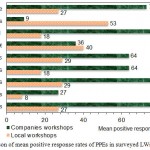 |
Figure 1: Comparison of mean positive response rates of PPEs in surveyed LWs and CWs.
|
The variables shown in y-axis are referred to OSH items of the studied element. The higher the mean positive response the best is the compliance referring to any particular OSH element. The OSH elements showing overall mean positive response (≥50%) were all in acceptable range. However, the values (≤50%) were considered as serious and required further actions for improvements of the concerning OSH element.
The highest positive response observed for PPEs at LWs (53%) and CWs (91%) were for items (knee and joint protecting mats are present and used) and (safety glasses and full body overall). A previous study at small workshops in KSA discovered that at surveyed workshops just 12% mechanics used PPEs all the time while 60% almost never used it. PPEs play a crucial role in preventing injuries, which are common occupational hazards at workshops.16 Non-use of dust masks may cause exposure to asbestos which is present in clutches and brakes due to its high resistance to heat. Long-term exposure to asbestos is life-threatening, although in new vehicles and parts its use has been banned, but many older parts and equipment still contain it. A Norwegian study at small mechanical workshops cited that due to use of PPEs, workplace accidents can be reduced significantly.22
The mean positive response for safety element fire protection and emergency management for LWs and CWs were 52 and 91% respectively (Figure 2). Fire protection and emergency management arrangements are very crucial for workplaces to tackle any emergency situation. According to HSE, UK preparation for emergencies can be the key for adequate emergency management.22 The mean positive response for first aid kit availability was poor among LWs because on average only 13% workshops were keeping first aid kits, although working in auto workshops carry high risks of injury, cut, burns and bruises hazards. Moreover, missing first aid kit at workshops is against the local regulations.1 Another Saudi study reports that 39% of surveyed workers were reportedly exposed to occupational hazards with injuries and accidents forming the majority.16 In LWs (fire extinguishers maintenance) item was found to be of highest positive response with 73%. This high response rate could be due to the strict monitoring of local enforcement agencies and compulsory Saudi building code adherence for all commercial buildings.
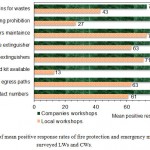 |
Figure 2: Comparison of mean positive response rates of fire protection and emergency management in surveyed LWs and CWs.
|
The variables shown in y-axis are referred to OSH items of the studied element. The higher the mean positive response the best is the compliance referring to any particular OSH element. The OSH elements showing overall mean positive response (≥50%) were all in acceptable range. However, the values (≤50%) were considered as serious and required further actions for improvements of the concerning OSH element.
The mean response of checklist component facilities provision at LWs and CWs was 69 and 94% respectively (Figure 3). The lowest scored (27%) item in this category was for the provision of the air conditioner at LWs, though it’s one of the most important safety items for workers’ health especially in the extremely hot weather conditions of KSA. On the other hand, the CWs scored 64% for the provision of air conditional but provided all the other listed facilities such as rest areas, toilets, drinking water, shadow and breaks with 100% response. Nevertheless, the LWs also showed the response of above 75% for all these items except for the provision of resting area with a score of 58%. The provision of all such facilities is also mandatory under amended labor law of 2015. Also, it’s against the law to work in the open sun between 15 July to15 September due to the severity of hot summer season, but many breaches were observed.
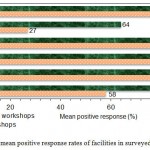 |
Figure 3: Comparison of mean positive response rates of facilities in surveyed LWs and CWs.
|
The variables shown in y-axis are referred to OSH items of the studied element. The higher the mean positive response the best is the compliance referring to any particular OSH element. The OSH elements showing overall mean positive response (≥50%) were all in acceptable range. However, the values (≤50%) were considered as serious and required further actions for improvements of the concerning OSH element.
The mean positive results for electric safety were 44% and 82% for LWs and CWs respectively. Some LWs were found to be overcrowded and electric wires, and cables were scattered thoroughly in working area. Moreover, the physical conditions of the cables and wires were not good as some were damaged and taped as evidenced from the lowest positive mean results of both items 29% and 27% respectively (Figure 4). Improperly wired and overloaded electrical circuits, trailing and damaged wires, no proper earthing for welding works can electrocute a mechanic. The possible reasons for such negative results might be the lack of resources, passive attitude, negligence of workers and supervisors, lack of hazards and risks awareness regarding the electricity as well as the smaller size of workshops.3,16
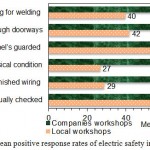 |
Figure 4: Comparison of mean positive response rates of electric safety in surveyed LWs and CWs.
|
The variables shown in y-axis are referred to OSH items of the studied element. The higher the mean positive response the best is the compliance referring to any particular OSH element. The OSH elements showing overall mean positive response (≥50%) were all in acceptable range. However, the values (≤50%) were considered as serious and required further actions for improvements of the concerning OSH element.
The average positive results for general workshop safety was 43% and 82% for LWs and CWs respectively (Figure 5). Among LWs, the most concerning item were prohibition of food and drinks which scored 0%. Moreover, other items such as floor conditions, workplace odor, OHS visual aids, and working benches conditions also scored below 25%. At LWs common observations were workshop floors cluttered, slippery, uneven, oily rags were present, unclean work benches and working area full of fuel odors. In comparison, the mean positive score for all safety items related to general workshop safety at CWs was above 70% except for workplace odor (46%). A Nigerian study reported that within the working area habit of eating and drinking is common among technicians and they wash their hands only occasionally before eating. This habit exposed such respondents to further risk.24
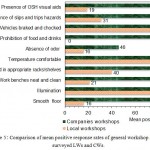 |
Figure 5: Comparison of mean positive response rates of general workshop safety in surveyed LWs and CWs.
|
The variables shown in y-axis are referred to OSH items of the studied element. The higher the mean positive response the best is the compliance referring to any particular OSH element. The OSH elements showing overall mean positive response (≥50%) were all in acceptable range. However, the values (≤50%) were considered as serious and required further actions for improvements of the concerning OSH element.
The mean positive score for component housekeeping among both LWs and CWs was 18% and 84% respectively (Figure 6). LWs score was unsatisfactory as only 18% among surveyed workshops had good housekeeping regarding oil, grease, water spillage free floors, general housekeeping, spillage immediate cleanup. The poorest result was found for the unavailability of chemical spill containment facility as not a single LW reported its use and availability, whereas its score was 73% among surveyed CWs (Figure 6). The surveyed CWs were all following best housekeeping practices and are maintaining international standards of safety for their workers and to maintain their corporate reputation. The mean positive score for all the safety items relevant to housekeeping was above 70%.
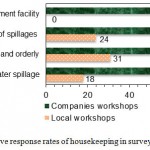 |
Figure 6: Comparison of mean positive response rates of housekeeping in surveyed LWs and CWs.
|
The variables shown in y-axis are referred to OSH items of the studied element. The higher the mean positive response the best is the compliance referring to any particular OSH element. The OSH elements showing overall mean positive response (≥50%) were all in acceptable range. However, the values (≤50%) were considered as serious and required further actions for improvements of the concerning OSH element.
The response for the OHS component of chemicals exposure was noted to be the poorest among all safety components of the survey checklist at all LWs. The mean positive response was only 16% at LWs as compared to the high response of 69% for CWs (Figure 7). Exposures to vapors and fumes of paint solvents and thinners were observed at all surveyed body paint workshops, no separated paint rooms are maintained in case of LWs. Common observations were that mechanics hands and arms were wet with oils, even their dresses were greasy, nails were full of grease and dust, they have commonly exposed to fumes of welding, gasoline vapors while decreasing and oil change and exposed to smoke exhausts with minimum or no protective measures. Other common practices at LWs observed were no proper exhaust and ventilation system maintained, uncovered oily rags bins, containers were unlabeled, waste oil was not stored and disposed of appropriately as well as MSDS were not available and even managers didn’t know about it. Workers face chemical exposures from gasoline, epoxies, fiberglass, solvents, asbestos, and fumes from welding, vehicles exhaust, paints, and adhesives. Most common chemical exposure (welding diesel, gasoline, kerosene oils, and paints) is by inhalation, others common route can be dermal while washing and degreasing different parts, while fixing of the atomizer, diesel oil pump, pistons rings and paint works.25 Such exposures along with unhealthy work environment can be detrimental to workers’ health.
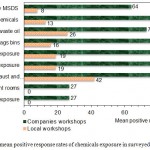 |
Figure 7: Comparison of mean positive response rates of chemicals exposure in surveyed LWs and CWs.
|
The variables shown in y-axis are referred to OSH items of the studied element. The higher the mean positive response the best is the compliance referring to any particular OSH element. The OSH elements showing overall mean positive response (≥50%) were all in acceptable range. However, the values (≤50%) were considered as serious and required further actions for improvements of the concerning OSH element.
Due to exposure to paints containing isocyanates occupational illness and diseases such as disabling dermatitis has been reported among workers. Such paints were considered as the main cause of occupational asthma in the UK in the past1. Exposure to gasoline via inhalation and ingestion can lead to lead poisoning and death in severe cases.26 Exposure to benzene at workplaces is considered as one of the main reasons behind blood disorders such as acute lymphoid leukemia, chronic myeloid and non-Hodgkin’s lymphomas.27 Handling lubricants and other workshop fuels with naked hands are due to some misconceptions among mechanics, some of them believed that lubricants and other fuels are not harmful when taken in small doses but indeed are purgative.3 The overall mean positive response in case of CWs for the chemicals exposure component was good, exposure to vapors and fumes of paints and oils was controlled by applying different techniques like separate oven rooms for painting, oil dispensers, and used oils were properly stored with the provision of proper safety measures. Respiratory protection was also provided to minimize paint fumes and vapors inhalation exposure while painting.
The OHS component service and maintenance were having a mean average response of 54% for LWs and 86% for CWs (Figure 8). This is an essential safety element and an integral part of any workshops. To carry out all service and maintenance operations safe and healthy working environment, conditions, procedures, and practices should be followed to ensure worker as well as customer’s safety and health. Among surveyed LWs the least response < 25% was observed for the unsafe practices related to gas cylinders like their physical condition was damaged, couplings and valves were oily and greasy, stored at unventilated places. The maximum positive result was observed for the item (parts are cleaned in dip tank) 85% among LWs and 100% among CWs) which gives a clue that exposure to fumes and vapors of oils is controlled. In case of CWs 100% mean positive response was also observed for lifting chains, jacks and slings service and maintenance and their physical condition as checked visually, it’s the responsibility of the supplier to service and maintains lifting equipment periodically as informed by the managers at CWs.
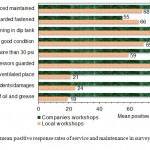 |
Figure 8: Comparison of mean positive response rates of service and maintenance in surveyed LWs and CWs.
|
The variables shown in y-axis are referred to OSH items of the studied element. The higher the mean positive response the best is the compliance referring to any particular OSH element. The OSH elements showing overall mean positive response (≥50%) were all in acceptable range. However, the values (≤50%) were considered as serious and required further actions for improvements of the concerning OSH element.
The mean positive rates for both LWs and CWs were good in case of component manual handling, i.e., 84% and 100% respectively (Figure 9). We inspected if mechanical aids, personal assistance, and handcarts for lifting, moving, carrying, pushing and pulling bulky and heavy items (tires, engine assembly, transmission box, gas cylinders) were available and used. Workshop workers are normally around heavy tools, equipment and machinery, they need to lift items that might cause strain on their back, and other musculoskeletal symptoms are also possible. They also spend a long time in many un-safe postures and lying on their back. Continuous and repetitive use of different tools may put them in awkward positions. The main factors with the working environment are repetitive movement, lifting and handling heavy loads, unsuitable body postures, workstation height, task design, manual handling, these factors outcomes are acute musculoskeletal injuries, i.e., a hernia, backbone stress, strain, pain, intervertebral disk rupture and tendon rupture4.
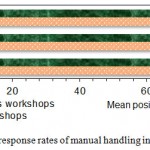 |
Figure 9: Comparison of mean positive response rates of manual handling in surveyed LWs and CWs.
|
The variables shown in y-axis are referred to OSH items of the studied element. The higher the mean positive response the best is the compliance referring to any particular OSH element. The OSH elements showing overall mean positive response (≥50%) were all in acceptable range. However, the values (≤50%) were considered as serious and required further actions for improvements of the concerning OSH element.
Auto mechanics use various types of tools, so the appropriate and safer tools are critical in ensuring OHS of the workers at the small workshops. The average positive response for the safety component tool safety was 58% among surveyed LWs and 91% among CWs (Figure 10). The maximum (77%) score was recorded for guarded power tools, while the least score (32%) was recorded for warning labels on tools question among LWs. In case of CWs maximum (100%) mean positive response was noted for two safety items, including i) tools placement at properly designated and marked places ii) instruction and warning labels present at tools and equipments. As part of their job, they may have to work with risky tools that can cut, smash and maul fingers and toes. Proper and arranged placement of tools and warning labels on equipment and machinery can be very beneficial for the operators and mechanics to operate safely which can prevent many injuries and severe accidents. Use of power tools in repairing industries causes physical vibration.22 Vehicle repair operations such as welding, gas cutting, and petrol-engine exhausts emit nitrogen dioxide, can cause emphysema, lung irritation, pneumonia, pulmonary edema, asthma, bronchitis, and respiratory infections. Mechanics deal with abrasive tools, sharp metals pieces and different parts which can be hot and rough causing injuries abrasions.
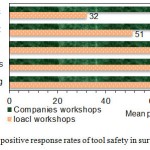 |
Figure 10: Comparison of mean positive response rates of tool safety in surveyed LWs and CWs.
|
The variables shown in y-axis are referred to OSH items of the studied element. The higher the mean positive response the best is the compliance referring to any particular OSH element. The OSH elements showing overall mean positive response (≥50%) were all in acceptable range. However, the values (≤50%) were considered as serious and required further actions for improvements of the concerning OSH element.
The overall mean positive response of all OHS elements, complying best practice/ regulations, at LWs was 47% which was quite low as compared to 84% of the CWs. The high positive response of CWs can be attributed toward the provision of better facilities, PPEs, top management commitment toward OHS, allocation of resources, state of the art tools and equipment, trained and educated management and labor force. Even some companies have maintained state of the art OHS and environmental standards at their workshops which in some cases are ISO certified and have an annual inspection and audit arrangements from international relevant firms. The OHS lower outcomes in LWs can be attributed toward managers/owners common believed perspective that OHS relies mostly on employee actions as well as other factors such as lack of resources, awareness, and workers relaxed attitude due to rare monitoring and site inspections. Most of the owners/managers agreed that providing a healthy and safe working conditions and PPE’s is their obligation, but they also consider that employees themselves are primarily responsible for their safety.6
The current study concluded that in small LWs overall OHS status is low as compared to the CWs. Working conditions, practices, procedures are not state of the art and workers knowledge regarding occupational hazards, and their use of protective measures was inadequate. Most workshops managers have no or very little knowledge, and awareness of OHS policies, regulations, principles and legislation and they always give it low priority. Especially in the local circumstances of Jeddah where almost all employees at such workshops are expatriates,3,16 so they also face some additional challenges of social, culture, language and information barriers. In Jeddah, traffic tailpipes are primary emission source of particles.14 A recent study at fuel stations found that concentrations of benzene, toluene, xylene, NO2, CO, PM2.5 and PM10 concentrations were 3114, 2143, 4326, 36, 2152, 344 and 710 µg m-3, respectively, higher than ambient air standards. At many locations workshops and fuel, stations are side by side in urban areas, so this bad air quality affects the workshops workers same as a fuel station.
The workers at many small local workshops also practice some unhygienic practices like living, housing, eating and drinking at the workshops which significantly increase the risk of exposure to workplace pollutants. Mechanics also face some special psychosocial pressures like long working hours, time pressure, carpal tunnel, trauma damages due to repetitive work schedules, unavailability of some parts; some parts got damaged while repairing, unforeseen delays, some rude customers, customer frustration when repairing costs exceeds customer budgets.22 Different studies recommended and highlight that OHS providers should know the exceptional need for preparing and delivering OHS information for expatriates workers.3,22 An Australian study at small enterprises indicates that exposure to workplace hazards was beyond permissible levels and access to OHS information was poor by expatriate and low-level literate workers.2 The current study offer insights into an understudied and hard-to-reach small business sector with an ample number and variety of physical, chemical and ergonomic occupational hazards. The workshops participating in our study were similar in size to those found throughout the KSA. Numerous deficiencies in OHS conditions, practices, procedures were found. Our study outcomes suggest that such small-scale enterprises could benefit from consultation assistance, intervention programs, and awareness workshops.
Limitations
It is possible that agreed and thus recruited LWs and CWs might have more interest in the researched those not agreed. As the visits were scheduled in advance, managers and supervisors may have improved, corrected and arranged some work practices, procedures and general housekeeping which may influence the overall results of the study. The approach of unscheduled visits is not practicable and acceptable in the local cultural, legal and social environment. In Jeddah, the local prevailing seasonal variation might affect survey results in terms of the provision and need for facilities, PPEs, evaporation rates and exposures to fuels and chemicals as environmental conditions varied significantly in summer and winter here in KSA. Shortcomings of the employed cross-sectional design can be another limitation. As the study approach is mixed (interview, FGDs, observation), subjective reporting of workers and managers may have some biases, attitude, and perception in some cases, affecting the overall accuracy of the obtained data.
Conclusion
This research highlights the outcome of an inspection survey for OHS status in MVRW in Jeddah, through observations, interviews, walk through survey and focused group discussions. At surveyed LWs, the OHS components such as PPEs (28%), electric safety (44%), general workshop safety (43%) scored lower than 50% satisfactory level, with most concerning safety elements of housekeeping and chemical exposure with the lowest score of 18% and 16% respectively. While other OHS components including fire protection and emergency management (52%), facilities (69%), maintenance and services (54%), manual handling (84%) and tool safety (58%) response rate were satisfactory and above 50%. The CWs, on the other hand, achieved a good response, above 50%, for all the OHS elements. For all the OSH elements included in this study, the overall mean positive response of 47% in LWs was much lower than the mean positive response of 84% in CWs. Increased inspection frequency together with provision and compliance to use of PPEs, training and other resources were identified as key in improving occupational health of workers.
Acknowledgments
Dr. Mohammad Rehan acknowledges the Center of Excellence in Environmental Studies (CEES), King Abdulaziz University (KAU), Jeddah, Saudi Arabia and Ministry of Education, Saudi Arabia for financial support under Grants No. 1/A/1436. Authors are also thankful to Deanship of Scientific Research (DSR) at KAU, Saudi Arabia for their financial and technical support to CEES. There is no conflict of interest.
References
- Ahmad I., Rehan M., Balkhyour M., Abbas M., Basahi J., Almeelbi T., Ismail I. M. Review of environmental pollution and health risks at motor vehicle repair workshops challenges and perspectives for Saudi Arabia. J. Agric. Env. Res. 2016;2:1-23.
- Seneviratne M., Phoon W. Exposure assessment in SMEs: a low-cost approach to bring OHS services to small-scale enterprises. Ind. Health. 2006;44:27-30.
CrossRef - Ahmad I., Balkhyour M. A., Abokhashabah T. M., Ismail I. M.,Rehan M. Workplace Safety and Health Conditions and Facilities in Small Industries in Jeddah, Saudi Arabia. Saf. Stud. 2017;3:37-52.
CrossRef - Heer V. Y. A. S., Subir D. A. S., Mehta S. Occupational injuries in automobile repair workers. Health 2011;49:642-651.
- Caldwell D. J., Armstrong T. W., Barone N. J.,Suder J. A., Evans M. J. Hydrocarbon solvent exposure data compilation and analysis of the AIHAJ-American Industrial Hygiene Association. 2000;61:881-894.
- Brosseau L. M., Parker D. L. B., Skan M.,Xi M. Workplace safety and health programs, practices, and conditions in auto collision repair businesses. Occup. Environ. Hyg. 2014;11:354-65.
CrossRef - Kamal A., Cincinelli A., Martellini T., Palchetti I., Bettazzi F., Malik R. N. Health and carcinogenic risk evaluation for cohorts exposed to PAHs in petrochemical workplaces in Rawalpindi city (Pakistan). J. Health Res. 2016;26: 37-57.
CrossRef - Ahmad I., Balkhyour M. A.,Abokhashabah T. M.,Ismail I. M.,Rehan M. 2017 b. Occupational Musculoskeletal Disorders among Taxi Industry Workers in Jeddah, Saudi Arabia. Biosci. Biotechnol. Res. Asia. 2017;14:593-606.
CrossRef - Munir S., Habeebullah T. M.,Mohammed A. M. F., Morsy E. A., Rehan M.,Ali K. Analysing PM2.5 and its association with PM10 and meteorology in the arid climate of Makkah, Saudi Arabia. Aerosol Air Qual. Res. 2017;17:453–464.
CrossRef - IBI G. Jeddah public transportation study. Ministry of Transportation, Saudi Arabia. 2007.
- Basahi J. M., Ismail I. M., Hussain H. K.,El-Behaedi E. H.,Hassan I. A. Air Pollution Assessment in Fuel Stations and its Impact on Workers’ Health: a Case Study from Jeddah,KSA. Adv. Environ. Biol. 2015;9:326-331.
- Hussein T., Alghamdi M. A.,Khoder M., AbdelMaksoud A. S.,Al-Jeelani H.,Goknil M. K., Hämeri K. Particulate matter and number concentrations of particles larger than 0.25 μm in the urban atmosphere of Jeddah Saudi Arabia. Aerosol Air Qual. Res. 2014;14:1383-1391.
- Khodeir M., Shamy M.,Alghamdi M., Zhong M.,Sun H.,Costa M., Maciejczyk P. Source apportionment and elemental composition of PM2.5 and PM10 in Jeddah City, Saudi Arabia. Atmos. Pollut. Res. 2012;3:331-340.
CrossRef - PME. Presidency of Meteorology and Environment, The Royal Kingdom of Saudi Arabia (http://www.pme.gov.sa/en/en_airpollution.asp). 2012.
- LFS (Labor force survey 2nd quarter, General Authority for Statistics) https://www.stats.gov.sa/sites/default/files/so-lfs-06-2016-en_2.pdf. 2016.
- Taha A. Z. Knowledge and practice of preventive measures in small industries in Al-Khobar. Saudi med. J. 2000;21: 740-745.
- Koshkaki R. R., Jahromi M. K.,Koshkaki A. R. A Study of the Status of Environmental Health at the Junior High-schools. Biosci. Biotechnol. Res. Asia. 2016;14:2307-2311.
- Koshkaki R. R., Jahromi M. K., Koshkaki A. R. Assessment of Environmental Health and Safety Status of Public High Schools in Jahrom City in Educational Year of 2015. Biosci. Biotechnol.Res. Asia. 2016;13(4).
CrossRef - Maher H. S., Babaeer A. L Awfi M. S. H. Prevalence Study of Hepatitis A Virus (HAV) on Jeddah Population. Biosci. Biotechnol. Res. Asia. 2011;8:585-590.
- Abbas M., Zakaria A. M., Balkhyour M. A., Kashif M. Chemical Safety in Academic Laboratories: An Exploratory Factor Analysis of Safe Work Practices & Facilities in a University. J. Saf. Stud. 2016;2:1-14.
CrossRef - Bejan A., Brosseau L. M.,Parker D. L. Exposure assessment in auto collision repair shops. J. Occup. Environ. Hyg. 2011;8:401-8.
CrossRef - Bull N.,Riise T.,Moen B. E. Work-related injuries and occupational health and safety factors in smaller enterprises a prospective study. Occup. Med. (Lond). 2002;52:70–74.
CrossRef - Health and Safety Executive (UK): Health and Safety in Motor Vehicle Repair and associated industries. HSG 261, HSE Books, ISSBN 9780717663088 [cited 2014 30 Mar]; Available from http://www.hse.gov.uk/pubns/priced/hsg261.pdf. 2009.
- Johnson O. E., Bassey E. A. Work Habits and Health Problems of Automobile Technicians at Mechanic Village, Uyo, Nigeria. Global Adv. Res. J. Med. Sci. 2016;5:136-142.
- Anslem O. A., Teddy C. A., Kevin A., Johnson K. F., Clement U. N. Reduced Haematological Indices in Auto-Mechanics and Fuel Attendants in Elele Nigeria. Am. J. Med. Biol. Res. 2014;2:1-4.
CrossRef - Anetor J. I., Babalola O. O., Adeniyi F. A. A., Akingbola T. S. Observations on the haematopoietic systems in tropical lead poisoning. Niger. J. Physiol. Sci. 2002;17:9-15.
- Carletti R., Romano D. Assessing health risk from benzene pollution in an urban area. Environ. Monit. Assess. 2002;80:135–148.
CrossRef

This work is licensed under a Creative Commons Attribution 4.0 International License.





